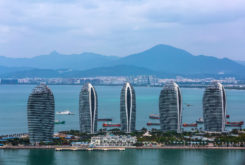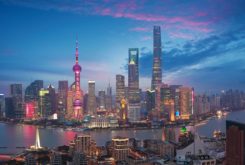On October 23, China’s President Xi Jinping will open the Hong Kong-Macao-Zhuhai bridge, the first land link between the SAR and the west bank of the Pearl River. At 55 kilometres, it is the world’s longest and most expensive bridge crossing the sea and cost US$17 billion; construction began in 2009.
President Xi will be the guest of honour at the opening ceremony, accompanied by Vice Premier Han Zheng and the chief executives of the two SARs, Chui Sai On of Macao and Carrie Lam of Hong Kong.
The bridge will open to traffic on October 24.
It is one of the key elements of the Great Bay Area (GBA), together with the high-speed train linking Hong Kong with Guangzhou that opened on September 23.
The GBA is one of China’s national economic strategies for the next 20 years. It includes Macao, Hong Kong and the nine largest cities of Guangdong province – Guangzhou, Shenzhen, Zhuhai, Foshan, Jiangmen, Zhaoqing, Huizhou, Dongguan and Zhongshan.
According to estimates by China Centre for International Economic Exchanges, by 2020, the total economic output of the GBA will be comparable to that of the Tokyo Bay Area. By 2030, its GDP will reach US$4.62 trillion, exceeding that of Tokyo and of the New York Bay Area, to become the world’s biggest bay in terms of economic scale. The total economic size of the nine cities account for 85 per cent of that of Guangdong province.
The bridge and the high-speed train help to realise the GBA plan to bring all the major cities in it in a travel radius of one hour.
Unique features
There are many unique features about the bridge. It is the world’s longest bridge-cum-tunnel sea-crossing with a dual three-lane carriageway 35.6 km in length from the shore of northern Lantau to the western shore of Pearl River Estuary.
It has a design life of 120 years. Design and construction have had to meet the standards of the Mainland, Macao and Hong Kong.
The bridge’s construction environment is complicated. The region is hit by frequent typhoons; the bridge crosses the Pearl River, one of the busiest cargo waterways in the world. It must meet high environmental standards and take into account the constant aircraft arrivals at the Hong Kong and Macao airports, which are both close to it.
It includes a 29.6-km dual three-lane carriageway in the form of bridge-cum-tunnel structure. There is a tunnel of about 6.7 km; two artificial islands for the tunnel landings west of the HKSAR boundary; civil and structural works, environmental measures, drainage, electrical and mechanical equipment and a traffic control and surveillance system.
Construction began in December 2009. The cost is being shared between three parties – the Hong Kong SAR government 42 per cent, the Macao SAR government 13 per cent and the Guangdong provincial government 45 per cent. Thousands of workers, Chinese and foreign, have been involved in the construction.
Price of blood
The Hong Kong Construction Industry Employees’ General Union has described the bridge as “a blood and sweat project”. According to the Association for the Rights of Industrial Accident Victims, 10 workers have died and more than 600 injured while they worked on the bridge’s construction site. The families of the dead have asked the Hong Kong government to erect a plaque in memory of those who lost their lives.
Many question the enormous cost of the project and ask if it will ever earn a return on the capital. They also criticise the lack of a railway line on the bridge, which would have been the fastest and most efficient way to carry passengers and cargo.
In the initial stages, the number of vehicles using the bridge will be limited. Drivers need to have licences for each of the three jurisdictions if they wish to enter them.
The Hong Kong Transport Department has limited the number of permits for cross-border private cars at 5,000. It will release a further 3,000 three months after the opening of the bridge. It has estimated that 29,000 vehicles will use the bridge per day by 2030.
Currently, nearly 28,000 vehicles in Hong Kong and 3,000 in the mainland have cross-border licences.
The busiest traffic in the early stages will be large buses. They will run every five minutes during peak hours, every 10 to 15 minutes during non-peak periods and every 15-30 minutes overnight. These buses will travel to two giant man-made islands outside Macao and Hong Kong, where they will pass through immigration and customs before continuing their journey on locally registered vehicles.
The long-term profitability of the bridge is threatened by two other bridges over the Pearl River currently under construction. The second Humen Bridge, 60 km north of Hong Kong, is scheduled for completion in 2019 and the Shenzhen-Zhongshan Bridge, just 30 km north of the HK-Macao-Zhuhai bridge, is due for completion in 2023. The tariffs on these are likely to be cheaper; travellers will not have to go through customs and immigration.



